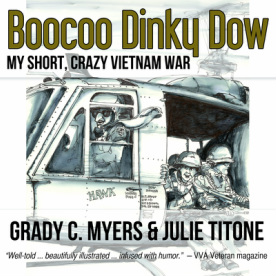 Like the recognition due to Vietnam veterans, it was a long time coming. But the audiobook version of "Boocoo Dinky Dow: My short, crazy Vietnam War" was worth waiting for. Grady Myers was a consummate storyteller, with a voice full of inflection, sound effects and damned-if-it-isn't-true panache. The audiobook narrator does Grady justice. He is Jeffrey S. Fellin, who is both an actor and a military veteran. He spent decades as a U.S. Army and National Guard helicopter pilot and instructor. Though Jeff was too young for Vietnam, he served with many pilots who flew in that war. He heard their stories and "Boocoo Dinky Dow" rings true to him. 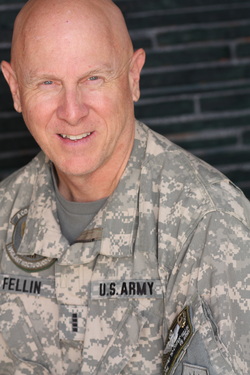 Jeffrey S. Fellin Jeffrey S. Fellin And he enjoys Grady's sense of humor. While he was recording the book, he emailed me to say: "Today I had to go back and edit out my laughing at Grady's writing about the animal names in his Basic Training battalion." Jeff got a double dose of basic -- first, in the Air Force in 1976. Then, after he finished college, he did Army basic in 1986. Another thing he shared with Grady was suffering in the line of duty. Jeff suffered a severe back injury while serving in the Germany. Plus, like Grady, he towers over most of us. Jeff is 6-foot-4, just an inch shy of Grady. "Reading this memoir I feel strangely connected to Grady, and lament that I will not be able to meet him in this life," he told me. "We share many parallels, like both being Medevaced half way round the world in a C-141, both recuperating at Fitzsimmons Army Hospital in Denver." He added: "My goal is to do PFC Grady proud by telling his story." He's done just that. The audiobook is available through Amazon, Audible and iTunes.
1 Comment
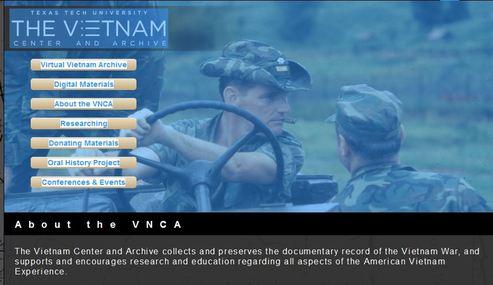 Boocoo Dinky Dow: My short, crazy Vietnam War has been accepted for inclusion in the Vietnam Center and Archive at Texas Tech University. Created in 1989, the archive is home to the largest collection of Vietnam related material outside the U.S. National Archives. How cool is that? Even if you can't visit Lubbock to go through the files and look at materials such as the Grady Myers memoir, you can sit at your computer and do research thanks to the collection's virtual archive. You can look in the map database. You can search the operations database. You can browse the oral histories and listen to folks tell their stories of Vietnam. (Too bad we don't have an audio interview with Grady to include.) How great to know that this part of our history -- difficult, controversial, significant -- is being saved for generations to study. 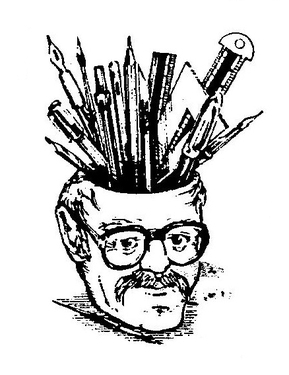 A Grady Myers self-portrait A Grady Myers self-portrait When a squad leader in Vietnam assigned Grady Myers to design a logo for the men's helmet covers, he became one of many people who sought the favor of Grady's artistic talents over the years. One of the first to do so was his pal Bob Benzon, an Air Force veteran who also served in 'Nam. Bob and Grady knew each other as young teenagers back in 1963-65. They were classmates at Otis Air Force Base in Massachusetts, where their dads were stationed. They lost track of each other after that. It wasn't until Bob learned about Grady's memoir "Boocoo Dinky Dow: My short, crazy Vietnam War" that he knew what became of his chum. In a recent letter, Bob described Grady as a natural artist. "He doodled in his school notebooks all the time, and did little sketches for me, but only with a bit of prodding. He could knock these things out very quickly in a style I could characterize as 'hurried realism.' The art people probably have a better name for the genre. No erasing, no modifications, just straight from pencil to paper, and that was so cool to me. His drawings (mostly of WWII subjects) put a person right there ... if you get my drift." Bob said most of the "Air Force brats" had at least a passing interest in the military. "Many followed in their father's footsteps into various branches, often over the objections of their parents. My theory on that is that most of our dads were WWII vets (boys back then wanted similar experiences), but the dads knew what combat could do to a person inside. So, when we went in, the dads were proud, but scared. "I served as a 2nd then 1st lieutenant pilot in the 362nd Tactical Warfare Squadron flying airplanes much older than I was, Douglas EC-47s. My war was quite benign ... take off, stooge around for a few hours fixing targets with radio triangulation, call the shooters in, land the airplane, over and over again. I was stationed at Da Nang, we only got hit once in the air. We got rocketed out of our beds once a week or so on base, but I cannot imagine what the Army guys out in the jungle went through." Guys like Grady, who came back with a Purple Heart and lots of stories. Bob, who lives in Virginia, returned from Vietnam without a scratch. A sharp salute to him for tracking me down to share his memories -- and, of course, for his six years of military service. 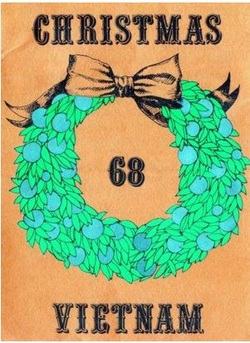 By Julie Titone "I’d been on the hill for a day when the cook decked out the food hut with Yuletide bunting. Choppers flew in with bins of hot holiday meals. Along with the food and mail came tasseled, tissue-lined, gold-lettered menus. Each one was stamped with a red and green shield of the United States Army in Vietnam and an address indicating the forthcoming turkey a la king had made its way to the front lines compliments of Gen. Creighton Abrams, commander of all U.S. forces in South Vietnam. " -- Grady Myers recounting Christmas 1968 in "Boocoo Dinky Dow: My short, crazy Vietnam War." As Grady goes on to explain in his memoir, the fancy dinner amid the squalor of Fire Support Base 30 came with a nasty little surprise from the enemy. Here's the U.S. Army menu from that day and the message that Abrams sent the troops. It begins: "Christmas has a special meaning for the soldiers who serve in Vietnam. Amid the tragedy and ugliness of war, the Holy Season reminds us of the joy and beauty of peace." Peace in Vietnam was a long time coming -- seven more years, in fact. But on Christmas Eve 1968, high above the madness of war, Apollo 8 astronauts were sending stunning photos from lunar orbit and their season's greetings "to all of you on good Earth." 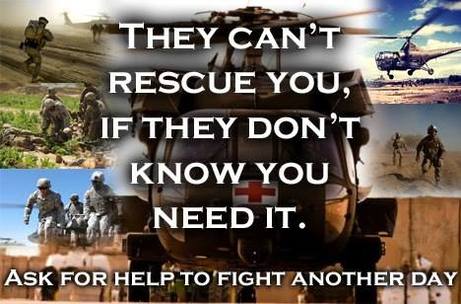 Grady Myers lay wounded in the heat of an ambush. If he called out for help, he knew he'd be shot again. If he didn't, his platoon mates would think he was dead, and he would end up in enemy hands. I thought of that battlefield scene when I saw this message: "They can't rescue you if you don't know you need it." Of course, it's meant to encourage military folks to get help dealing with mental trauma. Which also makes me think of Grady. You have to read between the lines of his vivid, sometimes funny memoir "Boocoo Dinky Dow: My short, crazy Vietnam War" to know that Grady went to war suffering from depression. And -- though he lived a rich life as an artist, friend and family guy -- the problem didn't go away. It's hard to say how much his war experience affected his state of mind. The lingering pain from physical wounds certainly took a mental toll. For sure, Grady didn't like the stereotype of the "crazy veteran," which would have made him reluctant to seek help for depression. For doubly sure, the illness contributed to the health problems that led to his death at age 61, long before the master storyteller had run out of tales to tell. Thankfully, the stigma of mental health problems is fading. Nowadays, if someone he knew hesitated to seek counseling, Grady would tell them to "Knock it off!" He'd urge them to speak up. Like he did in Vietnam. 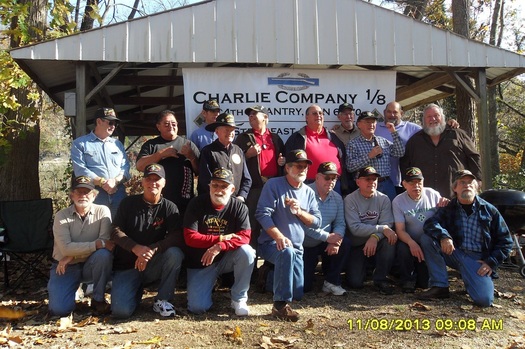 Charlie Company's 2013 reunion (courtesy of Bob Robbins) Charlie Company's 2013 reunion (courtesy of Bob Robbins) Grady Myers, whose Vietnam Army comrades knew him as Hoss, was ill by the time he knew about Charlie Company's annual November reunion in Branson, Mo. He died before he could attend. No doubt he'd have felt right at home there, telling tales and bragging about family with the best of them. Grady was an M-60 gunner in Company C, 1st Battalion, 8th Brigade, 4th Infantry Division. In his memoir "Boocoo Dinky Dow: My short, crazy Vietnam War," Grady explains, with amusement and chagrin, how Company C became known as Combustion Charlie. Its reputation for pyrotechnics began on Christmas Eve, 1968, just after Grady arrived at Fire Support Base 30. Holiday steam-letting got out of hand. Among other craziness, a guy calling himself Chicken Man took over the radio and broadcast some decidedly unofficial communications. I was reminded of that hilltop party when I came across this veteran's tape recording from that same Christmas -- in the case of this sober radioman at forward Landing Zone Jake in III Corps. 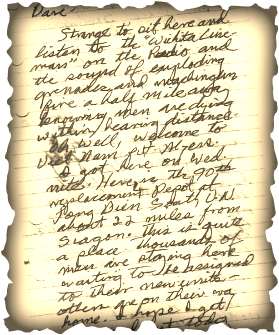 Strange to sit here and listen to the "Wichita Lineman" on the radio and the sound of exploding grenades and machine gun fire a half mile away, knowing men are dying within hearing distance. Oh, well. Welcome to Viet Nam Pvt. Myers. In the taped conversations that led to the memoir "Boocoo Dinky Dow: My short, crazy Vietnam War," Grady told me about his first days in-country. How he waited nervously at the replacement depot near Long Binh to learn what his assignment would be. But his anxiety became more vivid when I read his handwriting on pages torn from a skinny note pad. He was writing to his best buddy back in Boise, Dave Mueller. I was inspired to ask Dave for copies of the letters after watching the 1987 HBO documentary "Dear America: Letters Home from Vietnam." In it, soldiers' words are brought to life by such actors as Willem Defoe, Robert DeNiro and Matt Dillon. Many are words Grady could have written: "Vietnam has my emotions in a seesaw. This country is so beautiful ... " "I do things to make them laugh. They call me dinky dow. That means crazy." "This was the first body I saw." The dramatic readings accompany some fascinating video, both news clips interspersed and home-movie-style footage taken by the G.I.s. In one clip, Gen. William Westmoreland talks to an M-60 gunner like Grady. In another, NBC reporter Sander Vanocur, sitting on sandbags at Cam Rahn Bay in 1965, reports on the "recognition that there will be no easy, painless or quick way out of this struggle." The letters and videos are interspersed with statistics, such as the average age of the Vietnam soldier. It was 19. Grady's age. In their letters, soldiers sometimes put an upbeat spin on things, or at least left out the worst of the experience. It's a testimonial to their friendship that Grady shared many emotions with Dave. On Fort Lewis stationery, he made it clear that training was miserable. "I'm sick of green -- that's all there is in this damned place." (Whether he meant the uniforms or the pine-studded and ever-soggy landscape is unclear.) But he added: "I'm going through this with some outstanding men, some I've already struck up good friendships with." 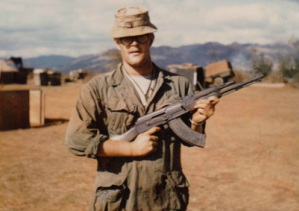 Grady Myers with a captured AK-47 Grady Myers with a captured AK-47 Always a big guy, he worried about his weight. He worried whether he'd be a good soldier. On the final flight into Vietnam, he wrote: "A few guys aboard are scared and some try to fend it off by being silly and making passes at the stewardesses -- which is fine with me 'cause I'm in on it too." He added that he was resigned to Vietnam and "going over there with a half-hearted spirit of adventure." Grady had talked about adventure as long as Dave had known him, since they met and bonded as newcomers to Borah High School. "We shared books about adventures we’d read. Now he was having his own. I remember being both scared for him and envying him for the camaraderie he had," says Dave, who describes his lifelong friend as someone whose compassionate, contemplative interior was masked by John Wayne swagger and humor. "There were deep philosophical thoughts going on inside that red-headed, fair-skinned noggin." In January 1969, after several weeks in Charlie Company, Grady wrote of feeling lost, overwhelmed and insecure. He was frustrated not to have any contact with the enemy. "We don't want any, but it seems to me, somehow, we're failing in our job, our duties." Contact came, of course. Grady's last letter to Dave was on American Red Cross stationery. "To make it simple," he began, "they shot me and I'm coming home." 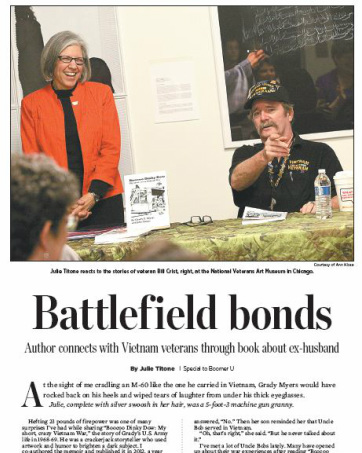 This article first appeared in The Spokesman Review. By Julie Titone At the sight of me cradling an M-60 like the one he carried in Vietnam, Grady Myers would have rocked back on his heels and wiped tears of laughter from under his thick eyeglasses. Julie, complete with silver swoosh in her hair, was a 5-foot-3 machine gun granny. Hefting 23 pounds of firepower was one of many surprises I’ve had while sharing “Boocoo Dinky Dow: My short, crazy Vietnam War,” the story of Grady’s U.S. Army life in 1968-’69. He was a crackerjack storyteller who used artwork and humor to brighten a dark subject. I co-authored the memoir and published it in 2012, a year after his death. The machine gun episode took place after a book reading at the Veterans Memorial Museum in Chehalis, Wash. Despite my uneasiness with firearms, I had been curious about the M-60, which soldiers called the pig. It’s what Grady humped through the tropical heat and up the mountainsides, what he was firing in the ambush that he barely survived. So when museum staff asked if I’d like to hold one, curiosity won out over discomfort. Good stories like Grady’s are timeless. Still, it can be a challenge to interest people in a book about a war that many don’t remember and others want to forget. One way I do that is to ask if there are any veterans in the family. One 50-something bookstore customer furrowed her brow and answered, “No.” Then her son reminded her that Uncle Bob served in Vietnam. “Oh, that’s right,” she said. “But he never talked about it.” I’ve met a lot of Uncle Bobs lately. Many have opened up about their war experiences after reading “Boocoo Dinky Dow.” Often a veteran’s first response to the book is a cheerful recognition of the title. “Dinky dow! I haven’t heard that in 40 years!” It is how American soldiers heard the French/Vietnamese phrase beaucoup dien cai dau, meaning very crazy. Vets regularly chide me for using the Urban Dictionary spelling of the slang expression. It should, they insist, be bookoo, or bucu. One gave me a lapel pin that reads “Dinky dau.” I was unprepared for my emotional connection to the scores of combat veterans I’ve met. The vets who chat with me after book readings. Who visit my living room. Who post comments on the “Boocoo Dinky Dow” Facebook page. How else to put this? I love these guys. Another surprise: the depth of readers’ curiosity about my relationship with Grady. Why, people wonder, would a woman put so much effort into sharing her ex-husband’s story with the world? I tell them that a writer can’t let a good story go to waste—certainly not a story about a gentle, nearsighted teenager who is transformed into a machine gunner nicknamed Hoss and thrust into an insane conflict on the other side of the world. My biggest motivation was to honor Grady. Even though we divorced long before he died, he remained a friend. (One of his platoon mates responded to this information by saying, “Well, that’s refreshing!”) Body counts, Agent Orange, Zippo raids, napalm, post-traumatic stress and political gamesmanship. All were signatures of the Vietnam “police action” (never officially a war), and I’ve learned a lot more about them in the last year. I’ve seen battlefield photos I’d like to banish from my brain. What I am happy to remember are the many personal stories I’ve gotten in return for sharing Grady’s. They’re like pieces of a puzzle. Put together, they create a picture of war’s trajectory and of its impact on our national psyche. I could fill another book with these stories. That unusually cheerful professor I know? Turns out he’d been a soldier who, after zipping so many buddies into body bags, came home determined to savor each day. Another veteran calls Vietnam the best thing that could have happened to him, because it kept him out of the family business, which was the Mafia. One fellow remembers strangers who, upon seeing his uniform, bought him drinks and meals. Another insists he was spat upon by war protesters. A former protester, still a peace activist, winces at the memory of menacing police dogs. One man did his best to stay out of Vietnam, then spent years wondering what he’d missed. A woman who wrote a friend one week into his tour of duty got the letter back, unopened. He didn’t live to read it. A widow only recently learned her husband had served in Vietnam; she discovered that while going through his papers after his death. One fellow recalls running through his college dormitory, deliriously happy that he’d gotten a high draft number. He passed other students who sat sullenly on their beds, letters in hand. A broad-shouldered Native American, handing me a book to sign, describes with pride how his platoon buddies called him Chief. “Anybody else, I wouldn’t let them do that.” A high school dropout from Brooklyn carried his platoon’s radio in Vietnam. Its antennae made him a ready target. But he survived his year in-country, earned a Ph.D. and became a leading authority on English composition. A Chicago fellow got drafted after one year of college and was so traumatized by his war experiences that he couldn’t return to the classroom. His dream of being a history teacher evaporated. A Washington state man survived four tours as an Army aerial gunner. He kept re-enlisting because he thought his talent for killing was keeping Americans alive. He returned home unscathed, became a long-distance trucker, then nearly died after a driver pulled in front of him. He married his nurse, raised a family and bought an Illinois tavern. Though I sometimes overdose on the subject of war, I haven’t tired of hearing stories or meeting veterans. I admire their resilience. I look beyond their gray hair and see them standing bronzed, slender and bare-chested in the red soil of Vietnam. I imagine them sitting down in a tavern, like the one in Illinois, laughing with Grady as he mimics helicopter sounds and talks about his crazy, explosives-happy buddies—including the ones who, eyes wide with fear, came running to save his life, “just like in the movies.” Julie Titone’s writing and photography have appeared in Northwest regional, national and international publications. 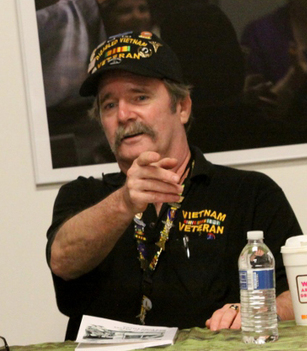 Bill Crist shares his stories Bill Crist shares his stories The military loves rank and insignia. Why not designate worthy veterans as Top Brass Volunteers? I'd nominate Bill Crist. Bill is a fixture at the National Veterans Art Museum, where Grady's work is part of the permanent collection. When I gave a reading from "Boocoo Dinky Dow" at the Chicago museum last spring, Bill was my guest veteran reader. (Because Grady died in 2011, I like to have a fellow join me to bring a male voice to the telling of his story.) Bill did more than read passages from the memoir. He talked about his own experiences with the Army's 25th Infantry in Vietnam. He told his stories with flair, conviction and a charming lack of political correctness. Afterwards, he gave the audience a tour of "The Things They Carried," an exhibit of military gear that he organized and helped finance. It struck me that Bill's greatest contribution is his willingness to talk about his own difficult journey since Vietnam. He told me some of his story after the museum reading. We met up at a neighborhood bar. He insisted on buying me a cocktail, but ordered a soft drink for himself. "I was an alcoholic for 15 years," Bill told me. "I was just trying to kill the bad memories in my head. Now I've been sober for 15 years." Post-traumatic stress was affecting him as soon as he came back, in 1971, from a world of sniper fire and body count competitions. Before being drafted, he'd started college. "I couldn't go back to school after 'Nam. I wanted to be a history teacher, but gave that up." 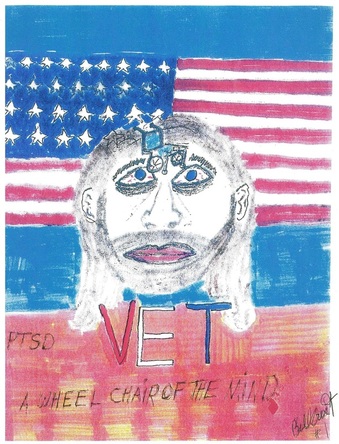 "PTSD Wheelchair of the Mind" by Bill Crist "PTSD Wheelchair of the Mind" by Bill Crist He found work in a warehouse, as a truck driver, as a salesman. Over the years, his stress piled up like so many sandbags on his soul. "I've been to Vietnam in my mind more than 300 times," he said. Eventually, he ended up at Hines VA Hospital, where he spent 50 days in the psychiatric ward. Art therapy was part of his treatment. One day, "a therapist asked us to draw something in our minds that was bothering us." Bill responded with "colors that kind of like to jump off the page and go after you." His illustrations of soldiers and veterans show troubled faces, bloody limbs, American flags. They ended up in the museum collection (see them here), even though "I never intended for anyone to see those drawings." Bill has lectured at Loyola University about his post-war trauma. When he takes student groups through the museum, he shares what happened during the war. The kids love trying on the rucksack that he donated to the exhibit. They like his candid recollections, such as the fact he didn't stand up when he had to pee in Vietnam because that was a sure way for a soldier to become a target. It's a tough sell to get veterans to volunteer and share their stories with the public, Bill said. He'd be glad to mentor anyone who'd like to soldier up and give it a try. 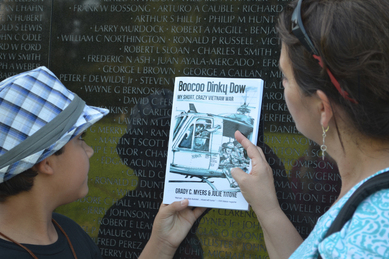 Ross and Maureen Ramirez Ross and Maureen Ramirez We use "heart of stone" to describe the absence of emotion. Yet the Vietnam Veterans Memorial in Washington, D.C., is stone that practically throbs with emotion. Sadness, memories and gratitude converge at the reflective granite. That's why I wanted Grady Myers's memoir "Boocoo Dinky Dow: My short, crazy Vietnam War" to be among the many items left there in remembrance. My sisters Maureen and Angela did the honors for me this summer. Angela lives in D.C.; Maureen and her family were visiting from Texas. Her husband Albert captured the occasion with these photos. Above, 10-year-old Ross and Maureen are holding the book below the name of Lt. George Callan. George, Joseph Strucel and Antonio Garcia died in the March 1969 ambush in which Grady was severely wounded. 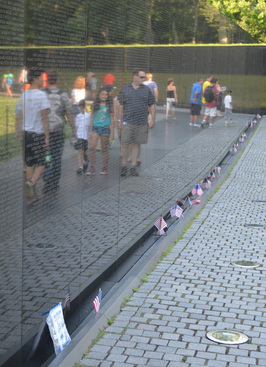 Respect reigns at The Wall Respect reigns at The Wall Ross had heard of the war, but didn't know much about it. He didn't know so many Americans had died in Vietnam. Like everyone who visits, he was impressed by the 58,286 names engraved in the granite. He also noticed how quiet and respectful the visitors were. "I had been to the memorial before but was still amazed at how far The Wall goes ... and how many are honored there," Maureen wrote to me later. "After reading 'Boocoo Dinky Dow,' it was more of a personal experience as the book gave a better idea of just what the soldiers like Grady and George went through. It was a hot, humid day and construction/detours to the memorial were frustrating, but nothing in comparison to what the soldiers experienced." Angela had visited several times since 1992. "When I've been before, it was just so crowded. But this time, there was hardly anyone there," she said. She was grateful not to be jostled by crowds, but added: "I just don't want people to forget." That doesn't seem to be happening. The Vietnam Memorial is 13th among the country's most-visited historic sites. People leave many things at the Wall, from yellowing letters to teddy bears. On the day that "Boocoo Dinky Dow" was propped up against the granite, it was momentarily alone because visitors' offerings had just been gathered up for the archives. For a touching account of the archive process, be sure to read The Things They Left Behind: Artifacts from the Vietnam Memorial. |
Julie Titone is co-author of the Grady Myers memoir "Boocoo Dinky Dow: My short, crazy Vietnam War." Grady was an M-60 machine gunner in The U.S. Army's Company C’s 2nd Platoon, 1st Battalion, 8th Regiment, 4th Infantry Division in late 1968 and early 1969. His Charlie Company comrades knew him as Hoss. Thoughts, comments? Send Julie an email. Archives
November 2018
|
 RSS Feed
RSS Feed